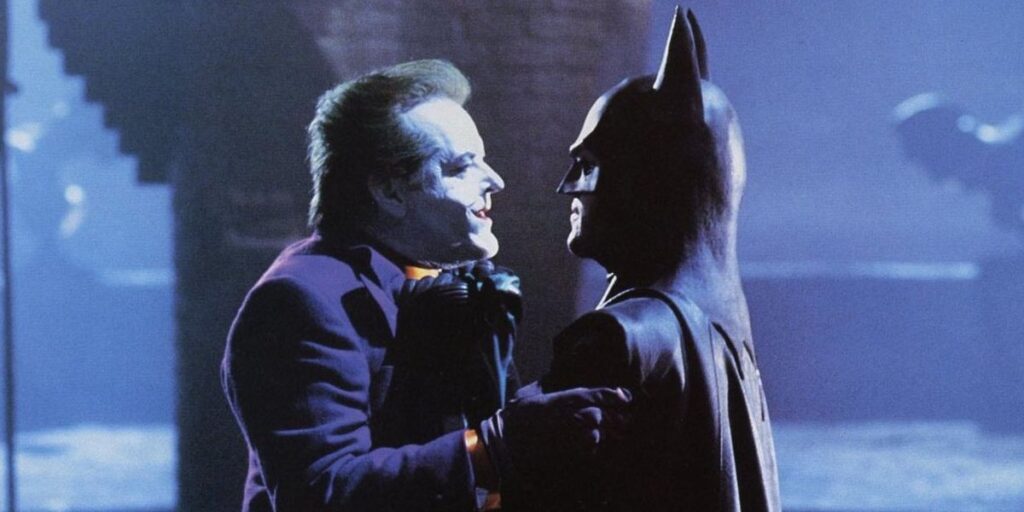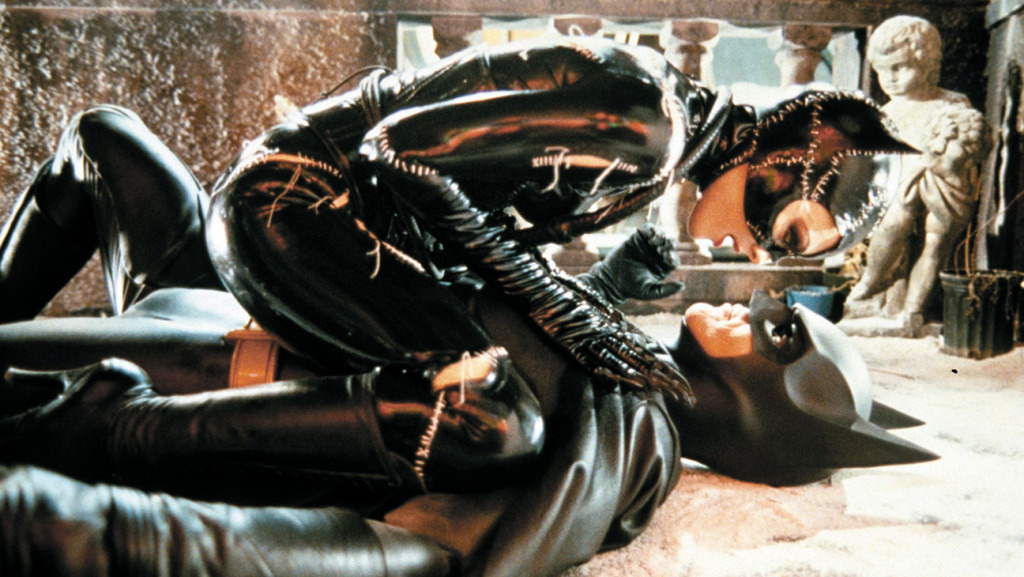Part 1: The Legacy of Tim Burton
Batman’s first Comic book appearance was in Detective Comics #27, released May 30, 1939. Since then, Bruce Wayne has appeared in eleven live-action films, twenty-nine solo animated films, and three solo animated tv shows. And those numbers exclude the numerous references to the caped crusader in greater popular culture, as well as the various guest appearances and cameos of the hero. Next month, with the release of Matt Reeves’ The Batman, there will have been twelve live-action films for Batman. That’s a whole lot of Batman, considering the second film appearance was in 1989, 33 years ago. So how did we get from Tim Burton’s Batman to Matt Reeves’ Batman? That is the question I want to investigate, to identify what elements have passed between films and filmmakers, and what has been left behind.
Batman (1989)
It’s impossible to understate the massive impact of Tim Burton’s Batman. Since the arrival of this film, there has been approximately one live-action Batman film made every three years. If we are to include every animated film and television appearance, then a Batman piece of film media has been released once every nine and a half months. And considering the largely disconnected nature of Batman media, this cultural dominance isn’t just impressive. It’s monolithic. And that all comes back to Tim Burton’s run with the character, which started here.
From the opening moments of Tim Burton’s Batman, you already have a picture painted of the great defender of Gotham City. This film is an icon; for many, it defined the caped crusader alongside the animated series. And returning to this film after 30 years, it’s easy to see why. Production Designer Anton Furst created the definitive Gotham City: gothic towers dominate the landscape, crime runs rampant through the streets, and alleyways are full of low-level thugs. And into this world, comes Batman. His costume is pure darkness, but the whites of his eyes and yellow of the belt buckle show him to be so much more. Unlike the underworld of Gotham, Batman is a guardian in those dark alleyways. And that is what Tim Burton captures so beautifully with cinematographer Roger Pratt.
Every element of the production design makes Gotham what it is. From the sleek design of the Batmobile and Bat-plane to the make-up of the Joker; Burton, Pratt, Lynda Armstrong and Furst complement each other perfectly. Burton uses shots of Batman posing to suggest the power of the dark knight. When Bruce Wayne is in front of the Bat-Computer, the harsh lighting gives weight to Keaton’s performance. Every special effect has the right amount of camp for this comic book adaptation, and it complements the eccentric performance of Jack Nicholson as The Joker. This film never strives for hard realism, instead of allowing its setting, lighting and visuals to create engagement from the audience. Those visual choices are so inspired, especially looking back from the 2010s era of realistic superhero movies.
But for as spectacular as Tim Burton’s visuals are, the story being told in this film is incredibly shallow. The characters populating Gotham have little resemblance to their comic book counterparts, and the plot itself is plodding and seemingly an afterthought. While Alan Moore would interrogate what it means to be Batman through his various comic book runs, Burton seems to not have an interest in Bruce Wayne’s psychology. Luckily, Micheal Keaton’s performance as an orphaned outcast billionaire injects the character with much-needed humanity to enable us to root for him throughout the film. And Batman isn’t the only character to truly feel like a shell in this movie. Batman is full to the brim of one-dimensional characters, from the beautiful and smart reporter, Vicky Vale (Kim Basinger), to the megalomaniacal and egotistical Joker/Jack Napier (Nicholson). The relationship between Vale and Wayne is built solely on natural chemistry between Keaton and Kim Basinger, thanks to their surface-level interactions in the script. And despite the plethora of screen time given to Basinger, it never truly enables Vale to appear as little more than a romantic partner and damsel in distress for Batman to save. Even Jack Nicholson’s truly unhinged take on the crown-prince of Gotham feels like an afterthought for the screenplay. And all of that is saddening because these performances are the bread and butter that give Batman its breath. Kim Basinger almost becomes the protagonist, uncovering who Batman is, and her performance makes me long for a Batman story centeredaround a reporter discovering Batman’s identity. Nicholson’s screen presence is impossible to deny, as he finds new ways to terrify the people of Gotham.
Batman is the strangest Batman movie, because the beauty of the film is found in the craftsman behind the camera. The story becomes secondary to the work of those who created this world. Tim Burton’s eye for iconography eclipses the story being told. And that design paid off huge, paving the way for the dominance that Batman has had within popular culture.
Batman Returns (1992)
Three years later, the first Batman sequel was released. Batman Returns was Burton’s second, and final, Batman film. It takes everything that worked in Batman and cranks those elements to eleven. The costumes and special effects got more disturbing, the performances embraced more camp, and the visual storytelling got even better. But what makes Batman Returns so good is its writing.
Batman Returns is a film about being alone. The Penguin (Danny DeVito) is alone, Bruce Wayne is alone, and Selina Kyle (Michelle Pfeiffer) is alone. And like the best ShaneBlack films, it places this story of loneliness at Christmastime. When families come together for the holidays, our central story focuses on those who have no family. And through that framing, we see how they cope with being outcasts. For the Penguin, it’s through manipulation and corruption. For Selina Kyle, it’s through acts of violence and flirtation. And for Bruce Wayne, it’s through fighting crime to protect the city. In spite of the darker, more violent nature of Batman Returns, this story fits in with the greater Batman canon. It dives into what makes these characters tick. And that is a massive step up from the previous outing.
As for the craftsmanship of this film, they really did crank the dials to eleven. The first major change that was made for this film was to have it set at Christmas, and the production design reflects this perfectly. Not only does this serve the story exceptionally well, but it makes for a Gotham city that feels a little bit brighter than before. In having Christmas lights and bright snow, the lighting of Gotham is able to reflect the effect Batman has had on the populace. It’s no longer the darkest city, but rather one of hope. It’s a city that embraces the weird people that populate it, instead of immediately shunning them. Production designer Bo Welch, a frequent collaborator with Burton, builds on Furst’s Gotham by adding details to the monolithic buildings. Shopping centers, walkways, greenhouses, and individual decor are added to enhance every detail of the story. Selina Kyle’s room is brought to life with neon lights, pink wallpaper, and a pullout bed. Max Shreck’s (Christopher Walken) business building is left massive yet hollow, much like the businessman himself. And The Penguin’s sewers are kept wet and grime-covered, painted with green lights. It’s effective because it keeps the characters front and center.
And those characters define this film. Costume Designers Bob Ringwood and Mary E. Vogt know how important iconography is to Burton’s world, so the costumes reflect these characters wondrously. Selina Kyle may be alone and often disregarded, but, as Catwoman, she demands what she wants. The skin-tight leather suit and Catwoman’s whip solidify her role as a femme fatale and perfectly exemplify what Selina wants to be. The Penguin’s costume is gross, excessively fat, with flippers for hands, and a massive pointed nose. And it’s perfect for describing who The Penguin is. And while Batman’s costume didn’t change for this film, it isn’t as bulletproof this time around. Bruce is forced to take off the mask in the third act, framing the themes of the film around Bruce Wayne, and not simply Batman.
The acting here is just as good, if not better than that of Batman. Keaton continues to deliver in spades, being immediately likable as both the shy Bruce Wayne and as the imposing Batman. He is given a lot more to do as Bruce Wayne, and once again elevates the screenplay. Alongside Keaton is Michelle Pfeiffer, who plays the famous anti-heroine Catwoman. Her performance is infused with both sincerity and camp, purr-fectly capturing the Catwoman of Burton’s Gotham. Add in the eccentric performance of Danny DeVito as The Penguin, and this film exceeds its predecessor.
Batman Returns is all about the weird outcasts coming to terms with who they are. It’s a very Tim Burton story, and yet it feels fresh because of the world it’s placed in. It’s a great Batman story about the cost of double identities in ways most other Batman stories aren’t. It’s a fantastical interpretation of Gotham city that reflects the caped crusader’s effect on the world. All in all, it’s a fantastic, albeit dark, Batman film.
It’s fascinating that audiences drew the line at Batman Returns with regards to its darker, violent story. The backlash to the film led to Tim Burton leaving the Batman franchise. The reactive nature of the studio led to Joel Schumacher’s lighter films aimed at younger audiences. But most importantly, it led to the creation of the Batman animated series. Batman: The Animated Series was a massive hit because it understood what Burton’s Batman did so well. And that was the importance of establishing a setting. Gotham’s gothic architecture, with flat rooftops, is a staple of the character. Without Gotham, there is no Batman. And Batman needs to be a larger-than-life figure, both within the screenplay and the visuals. And ultimately, it’s something that the trailers for Matt Reeves The Batman seem to highlight as well. The importance of visual storytelling hasn’t gone away, and hopefully, it will once again become a pillar of the superhero genre.
Join me next week as I review Schumacher’s Batman films, and discuss their impact on the Batman franchise.







